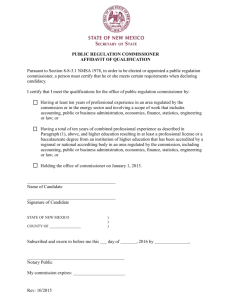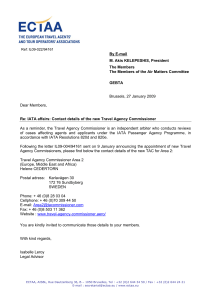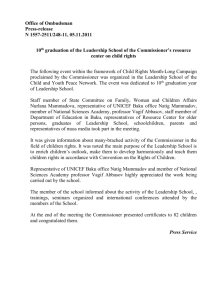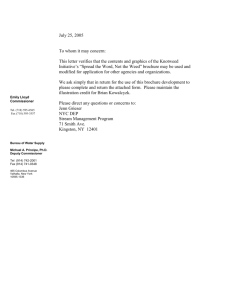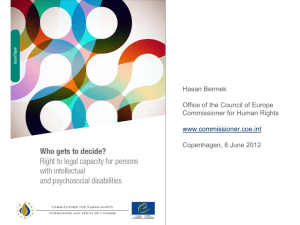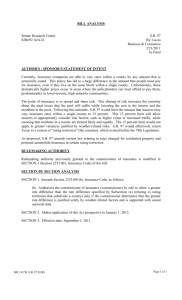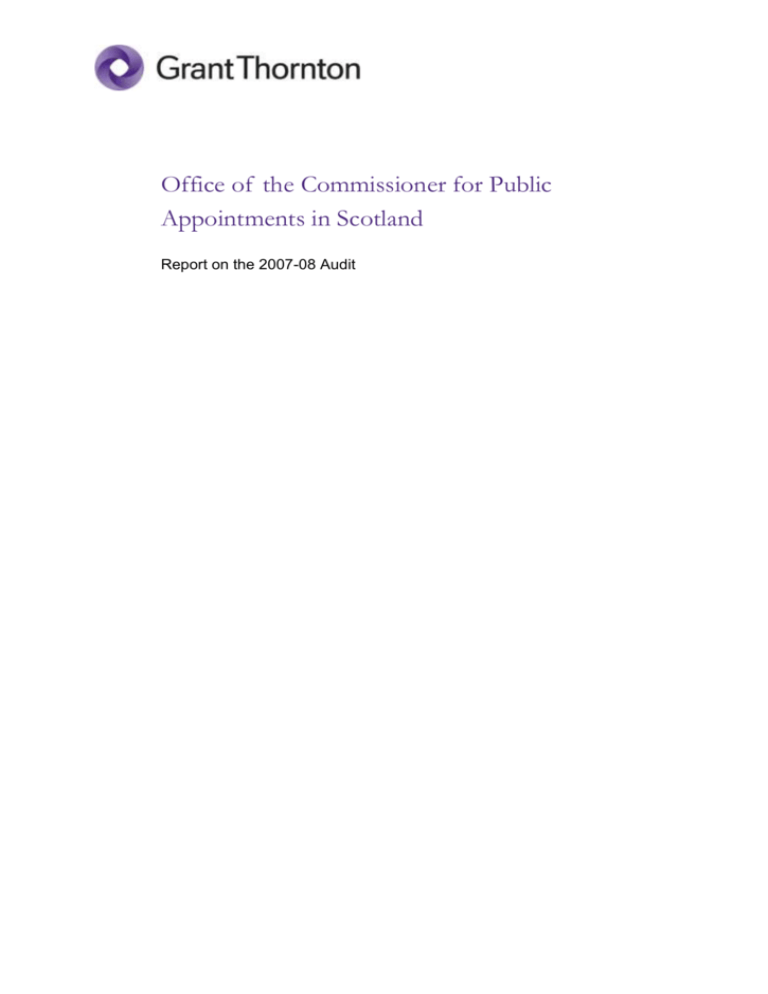
Office of the Commissioner for Public
Appointments in Scotland
Report on the 2007-08 Audit
Office of the Commissioner for Public Appointments in Scotland
Report on the 2007/08 Audit
Contents
Page
1
Executive Summary
1
2
Financial Statements
3
3
Governance
6
4
Performance
8
Appendices
Appendix A - Action Plan
10
Appendix B - Communication of audit matters to those charge with governance
11
© 2016 Grant Thornton UK LLP. All rights reserved
Office of the Commissioner for Public Appointments in Scotland
Report on the 2007/08 Audit
1
1 Executive Summary
Introduction
We have audited the financial statements of the Office of the Commissioner for Public Appointments in
Scotland (the Commissioner) for the 2007/08 financial year and examined aspects of the Commissioner’s
performance and governance arrangements. This report sets out our key findings.
Financial Statements
The Commissioner receives cash funding from the Scottish Parliamentary Corporate Body (SPCB) for
her annual budget. Expenditure during the year totalled £413k, matching the cash budget of £410,000
allocated to the Commissioner's office once accruals had been taken into account. Staff costs are the
main area of the Commissioner's expenditure at 45% of total expenditure, costs associated with
independent Assessors accounted for 28% of costs with administration (18%) and property costs (9%)
accounting for the remainder.
The Commissioner’s draft financial statements and supporting working papers were presented for audit
on 27 May 2008 and were of a high standard. This meant that few amendments were required to the
accounts or the annual report.
Governance
Overall, we found that the Commissioner's governance arrangements continue to operate well. The
Audit Advisory Board and team meetings are used to monitor the organisational risk register, financial
performance and progress against the business plan. We note that the Commissioner does not have an
internal audit function, and consider this appropriate in the context of the scale of the Commissioner's
operations.
Performance
The Commissioner has a Business Plan in place for 2007-10, which sets targets and outcomes for each
financial year. The business plan is linked to the Commissioner's risk register and is used to monitor
performance at team meetings.
Key achievements in 2007/08 include the publication and consultation on the Equal Opportunities
Strategy, and the completion of the first audit of the public appointments process since the new Code of
Practice was introduced in April 2006.
Although the Commissioner does not have a documented procedure in place for delivering Best Value,
arrangements are in place for strategic planning, linked to the budgeting process, for performance
management, and for delivering equal opportunities. We have therefore concluded that the approach in
place to deliver Best Value is commensurate with the size and scale of the Commissioner's operations.
The Way Forward
Our findings and recommendations are summarised in an Action Plan (Appendix A) that accompanies
this report. The Action Plan has been agreed with the Commissioner and incorporates the Management
Team's response to audit recommendations.
The report includes some specific recommendations to strengthen internal controls. It is the
responsibility of the Commissioner to decide the extent of the internal control system appropriate to the
organisation.
© 2016 Grant Thornton UK LLP. All rights reserved
Office of the Commissioner for Public Appointments in Scotland
Report on the 2007/08 Audit
2
Acknowledgements
We would like to take this opportunity to thank the Commissioner's staff who have been involved in the
audit for their assistance and co-operation.
This report is part of a continuing dialogue between the Commissioner and Grant Thornton and is not,
therefore, intended to cover every matter which came to our attention. Our procedures are designed to
support our audit opinion and they cannot be expected to identify all weaknesses or inefficiencies in the
Commissioner’s systems and work practices.
The report is not intended for use by third parties and we do not accept responsibility for any reliance
that third parties may place on it. The report will be submitted to the Auditor General for Scotland and
will be published by him on his website at www.audit-scotland.gov.uk.
Grant Thornton UK LLP
10 July 2008
© 2016 Grant Thornton UK LLP. All rights reserved
Office of the Commissioner for Public Appointments in Scotland
Report on the 2007/08 Audit
3
2 Financial Statements
Our Responsibilities
We audit the financial statements and give an opinion on whether:
they give a true and fair view, in accordance with the Public Finance and Accountability
(Scotland) Act 2000 and directions made thereunder by the Scottish Ministers, on the state of
affairs of the Commissioner as at 31 March 2008 and of net expenditure, recognised gains and
losses and cash flows for the year then ended;
they, and the part of the Remuneration Report to be audited, have been properly prepared in
accordance with the Government Financial Reporting Manual (FReM) and directions made
thereunder by the Scottish Ministers; and
in all material respects the expenditure and receipts shown in the financial statements were
incurred or applied in accordance with any applicable enactments and guidance issued by the
Scottish Ministers.
We also review the Statement on Internal Control by:
considering compliance with Scottish Government guidance;
considering the adequacy of the process put in place by the Accountable Officer to obtain
assurances on systems of internal control; and
assessing whether disclosures in the Statement are consistent with the information emerging from our
normal audit work.
Overall Conclusion
We are able to conclude that the Commissioner's financial statements give a true and fair view of the
financial position for the period from 1 April 2007 to 31 March 2008 and that, in all material respects,
the expenditure and receipts shown in the accounts were incurred or applied in accordance with
applicable enactments and relevant guidance. We also concluded that the management commentary
included within the Annual Accounts is consistent with the financial statements.
Standard of accounts and supporting papers
The Commissioner’s draft financial statements and supporting working papers were presented for
audit on 27 May 2008, in accordance with the agreed timetable, and were of a high standard. This
meant that few amendments were required to the accounts.
Office of the Commissioner for Public Appointments in Scotland
Report on the 2007/08 Audit
4
Financial Performance
The Commissioner receives cash funding from the Scottish Parliamentary Corporate Body (SPCB)
for her annual budget. Expenditure during the year matched the cash budget of £410,000 allocated to
the Commissioner's office.
Staff costs are the main area of the Commissioner's expenditure at 45% of total expenditure, costs
associated with independent Assessors accounted for 28% of costs with administration (18%) and
property costs (9%) accounting for the remainder. A more detailed analysis of the Commissioner's
2007-08 expenditure is shown in figure 1 below:
Figure 1 - Analysis of the Commissioner's expenditure
Legal Advice
£11k
Equal Opportunities
Strategy
£24k
Administrative
Costs
£41k
Staff costs
£184k
Property Costs
£37k
Independent
Assessors
£117k
As Figure 1 highlights, one of the key areas of expenditure for the Commissioner in 2007/08 was the
Equal Opportunities Strategy for public appointments in Scotland. The Commissioner consulted
widely on the draft Equal Opportunities Strategy, Diversity Delivers, which was published in November
2007. Responses to the consultation have been collated and will be used to inform the final Strategy
to be adopted in September 2008.
In 2007/08 the Commissioner made a report to Parliament on the first case of non-compliance with
the new Code of Practice. Legal advice was required as the Cairngorms, Loch Lomond and the
Trossachs National Park Authorities argued that the Code of Practice contradicted the legislation that
established them. This activity was unplanned and added £11k to expenditure which was financed
from savings elsewhere in the budget.
Internal Financial Controls
We conduct interim audit work to review the internal control framework in place at the
Commissioner's Office. We will review all of the systems of internal control on a cyclical basis over
the term of our appointment. During 2007-08 we have reviewed the arrangements for budgetary
control and the operation and effectiveness of internal controls over the payroll system and payments
to Assessors.
Our review identified weaknesses in segregation of duties controls relating to the authorisation and
payment of invoices under £500.
Action plan point 1
Office of the Commissioner for Public Appointments in Scotland
Report on the 2007/08 Audit
5
Statement on Internal Control
The Statement on Internal Control sets out the arrangements established and operated for risk
identification and management, proposed future development of arrangements, and review of
effectiveness of the system of internal control.
We are satisfied that the Statement complies with Scottish Government guidance, that the process put
in place by the Accountable Officer (the Commissioner) to obtain assurances on systems of internal
control are adequate and that the contents of the Statement are consistent with the information
emerging from our normal audit work.
ISA 260: Communication of Audit Matters to Those Charged with Governance
Our responsibilities in relation to the communication of audit matters to those charged with
governance are covered in the International Standard on Auditing 260. Outcomes against the
requirements of the Standard are reported in Appendix B to this report. In this context, all of the
errors we identified were adjusted within the accounts.
Office of the Commissioner for Public Appointments in Scotland
Report on the 2007/08 Audit
6
3 Governance
Introduction
Sound corporate governance is central to demonstrating Best Value, and incorporates the way in
which an organisation manages its business, determines strategy and objectives and goes about
achieving those objectives. It is concerned with structures and processes for decision-making,
accountability, control and behaviour at the upper levels of the organisation. Good governance
means:
focusing on the organisation’s purpose and on outcomes for citizens and service users;
performing effectively in clearly defined functions and roles;
promoting values for the whole organisation and demonstrating the values of good governance
through behaviour;
taking informed, transparent decisions and managing risk;
developing the capacity and capability of the governing body to be effective; and
engaging stakeholders and making accountability real.
As part of our 2007-08 audit we reviewed the Commissioner’s corporate governance arrangements
against best practice within the Scottish Public Finance Manual. We concluded that the
Commissioner's governance arrangements worked well within a generally sound system of internal
control. The Audit Advisory Board and team meetings are used to monitor the organisational risk
register, performance against budget and progress against the annual plan.
Budgetary Control
We reviewed the Commissioner's arrangements for budgetary control during our interim visit. We
found that strong links are in place between business planning and the annual budget process.
The annual budget is reviewed at the same time as the Business Plan to ensure that resources are
aligned to the Commissioner's objectives for the year. The Business Manager maintains a detailed
spreadsheet to monitor the budget on a monthly basis. At the time of our audit, steps were being
taken to address a predicted overspend, caused mainly by the unexpected nature of legal expenses and
higher than anticipated OCPAS Assessor activity. At the year end the Commissioner managed to
meet her annual budget without drawing on contingency funds, emphasising the strong budgetary
control arrangements in place.
The nature of the work undertaken by the Commissioner's office means that it is demand led. This
can lead to difficulties in accurate budget monitoring. At the time of our audit, we noted that the
Commissioner had 12 independent Assessors, who scrutinise the selection process for public
appointments. Each of the Assessors invoice the Commissioner's office for their work only at the
end of the appointment process. Each appointment process can take up to 6 months. This means
that the Business Manager needs to estimate how much work is involved for each appointment, and
budget accordingly. No timesheets are used and Assessors are asked to bill for work by day, with a
minimum unit of half a day. The average number of days work involved in an appointment in our
test sample was around 4.5 days, but the actual time invoiced varied from 3 days to 8.5 days.
Office of the Commissioner for Public Appointments in Scotland
Report on the 2007/08 Audit
7
Although Assessors informally keep the Business Manager up to date on each appointment, we
believe there would be benefit in asking Assessors to submit interim timesheets to allow the Business
Manager to better plan for expenditure. Since our interim audit, the Commissioner has recruited a
further 5 independent Assessors. We understand that the possibility of introducing quarterly billing
was discussed at the new Assessors' induction day and that plans are in place to present options to all
of the Assessors in September 2008.
Action plan point 2
Follow up of Prior Year Recommendations
We noted in our report on the 2006-07 audit that, in common with other Commissioner bodies in
Scotland, the Commissioner for Public Appointments had not received clarification regarding the
legal status of the officeholder, and therefore her personal liability. A number of Commissioner
bodies have now received legal advice on this issue. This advice confirms that there is no distinction
between the person who holds the office and the role of Commissioner.
As a result of the legal advice received, some of the Commissioners in Scotland, together with the
Scottish Public Services Ombudsman, have collectively agreed to contact the SPCB to discuss and
seek clarification on the matter. We will continue to monitor progress in this issue.
Office of the Commissioner for Public Appointments in Scotland
Report on the 2007/08 Audit
8
4 Performance
Introduction
Public audit is more wide-ranging than in the private sector and covers the examination of, and
reporting on, performance and value for money issues. As part of our annual audit we are required to
plan reviews of aspects of the arrangements to manage performance, as they relate to economy,
efficiency and effectiveness in the use of resources.
As Accountable Officer, the Commissioner has a duty to ensure public resources are used
economically, efficiently and effectively. Since April 2002 there has also been a duty on Accountable
Officers "to ensure arrangements are in place to secure Best Value."
Business Planning
The Commissioner has a Business Plan in place for 2007-10, which sets targets and outcomes for
each financial year. The business plan is linked to the Commissioner's risk register and is used to
monitor performance at team meetings.
Key achievements in 2007/08 include the publication and consultation on the Equal Opportunities
Strategy, and the completion of the first audit of the public appointments process since the new Code
of Practice was introduced in April 2006.
Equal Opportunities Strategy
The Commissioner published the draft Equal Opportunities Strategy, Diversity Delivers, in November
2007. The draft Strategy is based on a significant period of research into the type of people who
apply for and are appointed in the public appointments process. The Commissioner has reported
that the boards of public bodies do not currently reflect the population in Scotland. The research also
involved seeking views and perceptions on the public appointments process from interested parties.
Since November 2007, the Commissioner has held a series of public meetings and consultation with
interested parties. The results of the consultation will be incorporated into the final Strategy. The
Strategy includes a number of recommendations for improving the diversity of board members in
public bodies in Scotland. These include a communication campaign to raise awareness of the
opportunities available and more accessible materials both for publicising appointments and for
applications.
OCPAS has already taken steps to improve the diversity of candidates applying for public positions.
OCPAS delivered four workshops for the Ethnic Minorities Civic Congress in Aberdeen, Glasgow,
Dundee and Edinburgh during 2007/08. The workshops were designed to give people practical
instructions and guidance on applying for a public appointment. Over sixty delegates attended the
workshops, representing ethnic minority community-based groups from across Scotland.
Audit of the Public Appointments Process
During 2007/08, the Commissioner engaged consultants to carry out the first external audit of the
appointments process since the introduction of the new Code of Practice. The report examined six
appointments and generally gave the Commissioner a high level of assurance about performance
within appointment rounds. The report made a number of recommendations, largely around
documenting the decision making process are various stages when making a decision about the
appointment.
Office of the Commissioner for Public Appointments in Scotland
Report on the 2007/08 Audit
9
The Commissioner has decided to carry out future audit reviews using internal resources to ensure
that they draw upon the expertise of OCPAS staff and Assessors.
OCPAS also regularly survey public bodies involved in appointment rounds to seek views on the
appointment process. This allows the Commissioner to monitor performance throughout the year.
Best Value
The Commissioner's office is relatively small, with limited management capacity. At present, the
Commissioner's approach to best value is restricted to monitoring efficiency in operations.
Arrangements are already in place for strategic planning, linked to the budgeting process, and for
performance management. During 2008/09 the Commissioner will also adopt Diversity Delivers, to
help promote equal opportunities in the public appointments process. We have therefore concluded
that the approach in place to deliver Best Value is commensurate with the size and scale of the
Commissioner's operations.
Office of the Commissioner for Public Appointments in Scotland - Report on the 2007/08 Audit
10
Appendix A - Action Plan
No
Finding
Financial Internal Control
1
We noted that the Business
Manager can sign invoices below
£500 as authorised for payment.
Budgetary Control
2
We noted that each of the
Assessors invoices the
Commissioner's office for their
work only at the end of the
appointment process. We noted
that the average number of days
work involved in an appointment
can vary from 3 days to around 8.5
days.
Risk
Recommendation
Management Response
Implementation date
Med
OCPAS should ensure that there is
adequate segregation of duty between
authorisation and payment of invoices.
Each month, a list of invoices authorised From July 2008
solely by the Business Manager will be
provided to the Commissioner.
Low
OCPAS should consider asking
Assessors to provide estimates of time
spent on appointments on a quarterly
basis. This would allow more reliable
budget planning.
To address this issue, OCPAS will Proposals – Sept 08
develop an alternative billing method for
OCPAS Assessors. Initial proposals will Pilot – Oct-Dec 08
be put to Assessors and piloted during
2008-09 with full implementation by Implement – by Apr 09
2009-10.
Office of the Commissioner for Public Appointments in Scotland - Report on the 2007/08 Audit
Appendix B- Communication of audit matters
to those charged with governance
ISA 260 – Communication of audit matters to those charged with
governance
Under ISA 260, we are required to consider matters of governance interest that arise from the
audit of the financial statements and communicate them with those charged with governance.
The areas considered are as follows:
a) Relationships that may bear on Grant Thornton’s independence and the integrity and
objectivity of the audit engagement lead and audit staff;
b) The overall approach to the audit including any limitations thereon, or any additional
requirements;
c) The selection of, or changes in, significant accounting policies and practices that
have, or could have a material effect on the entity’s financial statements;
d) The potential effect on the financial statements of any material risks and exposures,
such as pending litigation, that are required to be disclosed in the financial
statements;
e) Audit adjustments, whether recorded or not by the entity that have, or could have a
material impact on the entity’s financial statements; and
f)
Those uncorrected misstatements aggregated by the auditor during the audit that
were determined by management to be immaterial both individually and in aggregate
to the financial statements as a whole.
Key Findings
We summarise our key audit findings in relation to the above areas.
Ref
Key Messages
Area
We are able to confirm our independence and
objectivity as auditors and note the following:
A
Independence
we are independently appointed by Audit
Scotland;
we comply with the Auditing Practices
Board’s Ethical Standards; and
we have not performed any non Code of
Audit Practice (the Code) or advisory work
during the year.
11
Office of the Commissioner for Public Appointments in Scotland - Report on the 2007/08 Audit
Appendix B- Communication of audit matters
to those charged with governance
Ref
Key Messages
Area
Our approach to the audit was set out in our
2007-08 audit plan. We have planned our
audit in accordance with International
Auditing Standards and the Code. Other key
factors to highlight include:
B
C
D
E
we consider the materiality of items in the
financial statements both in determining
the approach to audit them and in
determining the impact of any errors;
we have been able to place appropriate
reliance on the key accounting systems
operating at the Commissioner's office for
final accounts audit purposes only; and
we have been able to place reliance on the
work of internal audit in respect of the key
accounting systems.
Approach to the audit
Accounting policies and
practices
Material risks and
exposures
Audit adjustments and
unadjusted errors
We consider that the Commissioner has
adopted appropriate accounting policies in the
areas covered by our testing. Accounting
policies adopted were in accordance with the
Government Financial Reporting Manual
(FReM).
The Commissioner has considered and
confirmed her office remains a going concern.
The Commissioner is asked to confirm this
through the Letter of Representation.
The Commissioner has considered and
confirmed that her office has no material risks
and exposures which should be reflected in
the financial statements. The Commissioner is
asked to confirm this in the Letter of
Representation.
We identified several minor disclosure
amendments and reclassifications to improve
the presentation of the accounts. These are
outlined below. There were no material errors
that were not adjusted in the accounts.
12
Office of the Commissioner for Public Appointments in Scotland - Report on the 2007/08 Audit
13
Appendix B- Communication of audit matters
to those charged with governance
Accounting Issues
Classification of Payments on Account
During testing, we noted that two payments on account had been netted off the creditors
balance. This meant that creditor and debtor balances could not be directly compared with
those in the prior year. We therefore asked that the payments on account be correctly
reflected in the financial statements as prepayments.
Summary of adjusted audit differences
This is a summary of audit differences processed by the Commissioner's office during the
course of our audit.
Income & Expenditure
account
Dr
£s
Cr
£s
Balance Sheet
Dr
£s
Cr
£s
Adjustments affecting reported results
Adjustment for payments made on account
Prepayments
Creditors
There are no material unadjusted differences to report.
2,891
2,891

